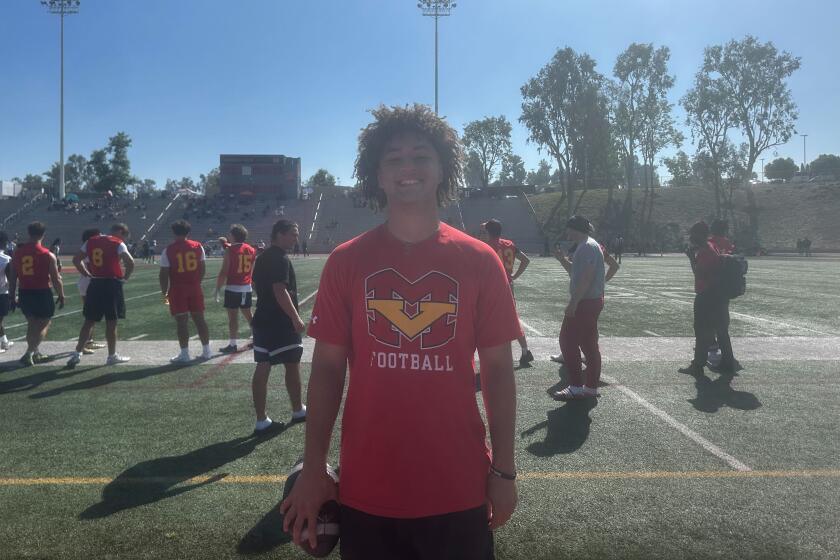Some schools are playing short-handed
- Share via
All week long, Alondre Logan had a headache he couldn’t shake.
It started on a Thursday, when the Lucerne Valley High quarterback took a hard hit and lingered in a way that suggested he had suffered a concussion.
But Lucerne Valley doesn’t have the money to employ a full-time athletic trainer and Logan did not tell the football coaches about the lingering headache. So it wasn’t until after the next game eight days later, after he had played again, that anyone learned about his symptoms.
“I did not know,” Coach Chris Klinger said, shaking his head.
Although Southern California schools do their best to provide medical care at games, relatively few can afford to have trained personnel at practices during the week.
Among the Los Angeles City Section’s 100 schools, for example, officials estimate that only a handful have full-time trainers.
“That’s a problem … a huge problem,” said C. Thomas Vangsness, a USC orthopedic surgeon who volunteers as team doctor for Garfield High.
There were an estimated 258,614 practice injuries nationwide in 2009-10, according to a study by the Center for Injury Research and Policy in Columbus, Ohio. That represents 44% of estimated football injuries for the school year.
There were also significant numbers of practice injuries in other sports, including soccer, basketball and wrestling.
In football, tempo is a big part of the problem. Everyone plays hard Friday night, but that is not always the case during endless drills Tuesday and Wednesday afternoons.
“One guy is going full speed and the other guy is going half speed,” St. Paul Coach Marijon Ancich said. “I’ve seen it happen so many times I can’t believe it.”
Trainers can help in several ways.
Unlike sideline doctors who usually see teams only once a week, they monitor athletes day by day, checking on proper rehabilitation.
With concussions, they can keep track of when symptoms subside, which can get athletes back on the field more safely and, in some cases, sooner.
“I interact with the trainers all week,” said Richard Ferkel, an orthopedic surgeon who serves as team doctor at Harvard-Westlake School in North Hollywood. “It improves the quality and continuity of care demonstrably.”
The trainer at Buena Park High recently intervened when defensive back Eric Ascencio wanted to keep practicing. Ascencio thought he had a pulled muscle in an ankle.
“If she wasn’t there, I probably wouldn’t have gone to get X-rays,” he said of trainer Carmen Macall. “I would never have guessed it was a fracture.”
Medical personnel at practice can also help prevent injuries from occurring in the first place, working with athletes on strength training, nutrition and proper stretching.
Keith Feder, a Manhattan Beach orthopedic surgeon and the medical director for Team to Win, which supplies sideline medics to various schools, said: “Having an athletic trainer on campus would save the healthcare system so much money, it’s ridiculous.
“Kids wouldn’t have to go to the emergency room as often, they wouldn’t have to go to a physical therapist outside of school for minor injuries and, most importantly, it would reduce the risk of catastrophic injuries,” Feder said. “For the amount they pay an athletic trainer, the return is huge.”
But many schools simply cannot find room in their slimmed-down budgets for an extra $40,000, the average salary for high school trainers, according to a recent survey by the National Athletic Trainers’ Assn.
At Lucerne Valley, down the mountain north from Big Bear in the southern region of the Mojave Desert, coaches say the 30- to 40-minute ambulance response time leaves them feeling especially vulnerable during practices.
David Spann, a running back and linebacker for the Mustangs, broke his collarbone during a scrimmage this season, yet continued to play because no one spotted the injury.
“He didn’t hang his shoulder down and he didn’t complain of being hurt,” Klinger said.
Spann’s mother, Linda Davis, took a realistic view of the situation.
Football is important, she believes, because it gives students a reason to keep their grades up. She also knows these are tough times.
“Our school can’t afford it,” she said of a full-time trainer, “and we’re doing what we can to have a sports program.”
twitter.com/LATimesWharton
Times staff writers Baxter Holmes and Eric Sondheimer, and correspondent Melissa Rohlin contributed to this report.
More to Read
Get our high school sports newsletter
Prep Rally is devoted to the SoCal high school sports experience, bringing you scores, stories and a behind-the-scenes look at what makes prep sports so popular.
You may occasionally receive promotional content from the Los Angeles Times.







